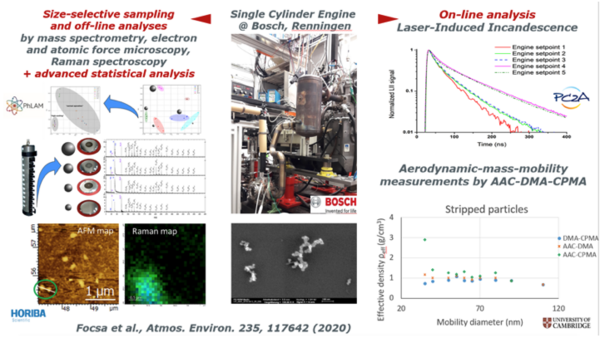At the Crossroads of Science and Society: from the laboratory to European policies
MPI was a major player of the H2020 PEMS4Nano project dedicated to the development of a new portable measurement system (and associated methodology) to count non-volatile nanoparticles emitted by internal combustion engine vehicles in real driving conditions. The project gathered the expertise of two academic partners (ULille, U. Cambridge) and seven industrial partners (among them HORIBA, Bosch, TSI, Idiada). The current European regulations (Euro 6d) impose upper limits on the mass and number concentrations of particulate matter emitted by on-road vehicles. In the terms of particle size, the current measurement limit is 23 nm. However, the engine and post-treatment systems technological evolutions shifted the exhaust particles size-distribution to lower values in the nm range (with increased health risks). The “book of charges” established by the European Commission in the GV02 (Green Vehicles) call was therefore targeting the development of new robust methodology for measuring particles below to the current limit (down to 10 nm). Three projects (PEMS4Nano, Downto10, and SUREAL-23) were granted funds and worked in parallel on the subject.
During the 39 months of the PEMS4Nano project (10/2016 – 12/2019), intensive work was performed by all partners on the emissions sampling and characterization, instrumental and methodological design and testing. Several sampling and measurement campaigns were performed on the Robert Bosch GmbH facilities in Renningen (Germany), on-track tests were also performed on the Idiada (Santa Oliva, Spain) circuit. The PMI task was mainly in the off-line characterization of size-selected particulate matter by various techniques, such as laser-assisted mass spectrometry or vibrational micro-spectrometry. The main results of this joint effort were published in an extensive paper in 2020 (FOC-20). Other papers targeted the effect of a catalytic stripper (a key component of the developed instrument and methodology) on the measurement chain (DUC-21b; KAZ-22]). The long-standing collaboration with our colleagues from the PC2A Laboratory (UMR 8522), pursued in the frame of the PEMS4Nano project, led to important fundamental developments on the analytical methodology, as illustrated in several papers, two of them being honored by journal covers (IRI-18-cover; DUC-19-cover). The collaboration with HORIBA led to AFM-Raman measurements of soot particles as small as 6 nm, which made the object of a worldwide broadcasted application note.

The three GV02 projects (PEMS4Nano, Downto10, and SUREAL-23) jointly published a “roadmap” paper on the “Perspectives for regulating 10 nm particle number emissions based on novel measurement methodologies” ([SAM-22]). The proposed methodology, fostered by the Particle Measurement Programme International Working Group, was approved in June 2020 by the United Nations Economic Commission for Europe (UNECE) and is now part of the Euro7 regulation proposed by the EC. We believe this is a thrilling example of how academic research pairing up with industrials can contribute together to offering a sound basis for public policy deciders. The international visibility gained through this project also led to our invitation to join the Particle Measurement Programme (2019) and the International Working Group set in 2020 by the Canadian Government to design new methodologies for measuring maritime transport emissions.
